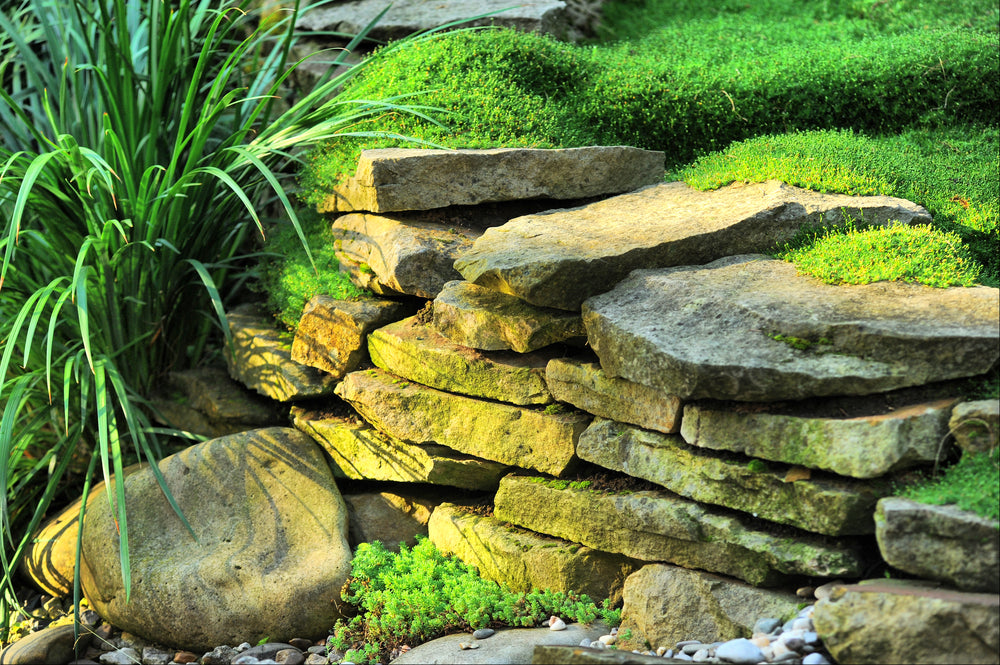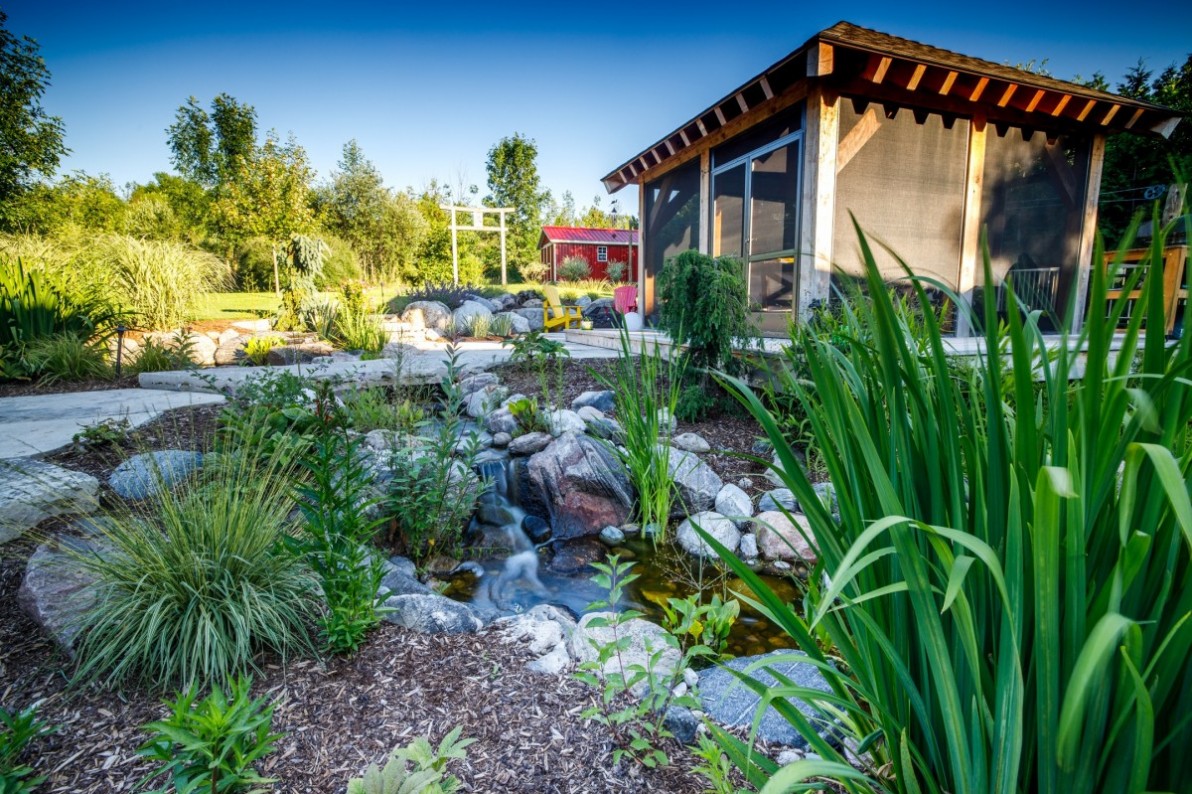Transform Your Backyard Oasis with Expert Tips from Landscaping St. Louis MO
Transform Your Backyard Oasis with Expert Tips from Landscaping St. Louis MO
Blog Article
Check Out Cutting-edge Approaches to Enhance Your Property's Visual With Landscape design
Exploring cutting-edge landscaping approaches can transform a building's aesthetic and capability. By incorporating native plants and hardscaping, house owners can produce lasting and structured environments. In addition, the thoughtful use of shade concept and water attributes enhances visual appeal. As exterior areas come to be extensions of the home, recognizing just how to incorporate these components successfully is vital. This discussion will uncover strategies that raise both elegance and usability in exterior settings.
Welcome Native Plants for Sustainability
As climate modification and metropolitan growth proceed to influence local ecological communities, welcoming indigenous plants for sustainability has come to be increasingly vital. Native plants are well-adapted to regional climates, dirt kinds, and wild animals, requiring less water and fewer chemical inputs compared to non-native types. Their growth supports neighborhood biodiversity, fostering habitats for pollinators, birds, and other wildlife. By incorporating native flora right into landscapes, property proprietors can produce vibrant, lasting environments that reflect the region's all-natural beauty.Furthermore, native plants improve soil health by promoting useful bacteria and lowering erosion. They additionally contribute to carbon sequestration, aiding alleviate environment change results. The visual appeal of indigenous yards can be just as enchanting as typical decorative styles, showcasing seasonal blossoms and varied structures. Ultimately, accepting indigenous plants not just sustains eco-friendly equilibrium however also enhances the community's visual landscape, motivating a deeper connection to the environment.
Include Hardscaping for Framework and Function
Hardscaping plays a crucial function in enhancing both the framework and functionality of outside areas - St. Louis MO landscaper. By selecting sturdy products and purposefully planning the format, homeowners can develop functional environments that match their landscaping. The integration of hardscape components not only adds visual interest but also offers practical purposes, such as enhancing ease of access and handling water drainage
Advantages of Hardscaping
While lots of homeowners focus mainly on softscaping elements, incorporating hardscaping right into a landscape design provides various benefits that enhance both framework and feature. Hardscaping, that includes attributes such as patio areas, walkways, and keeping wall surfaces, gives a solid structure for exterior spaces. It develops specified locations that boost motion and use, urging exterior activities and celebrations. In addition, hardscaping can help handle water drainage, minimizing disintegration and promoting healthier plant life. Additionally, these functions add visual appeal, adding to the overall design harmony of a home. By balancing softscaping with hardscaping, home owners can produce visually striking landscapes that are not only beautiful yet likewise useful and lasting for years to find.
Materials for Sturdy Layout
Including hardscaping not just boosts the visual appeal of outdoor spaces but also counts greatly on the selection of products that ensure longevity and functionality. Top notch concrete, all-natural rock, and brick are popular alternatives for sidewalks, patio areas, and wall surfaces, providing a robust foundation that withstands climate aspects and heavy foot website traffic. Compound materials supply the appearance of wood without the maintenance, making them appropriate for decking and fence. In addition, permeable pavers enable effective drain, advertising environmental sustainability while keeping structural stability. Metal accents such as railings and sculptures can present modern panache and strength. By picking the ideal products, residential property proprietors can create aesthetically striking landscapes that stand the test of time and enhance their outdoor living experience.

Planning Functional Outdoor Spaces
Just how can one effectively plan outside spaces that stabilize aesthetic appeals with functionality? Incorporating hardscaping aspects is important in achieving this balance. Functions such as outdoor patios, pathways, and maintaining wall surfaces not only provide structure however likewise boost the aesthetic charm of the landscape. By strategically placing these aspects, one can develop specified areas for tasks like amusing, gardening, or relaxation.Moreover, picking products that enhance the natural surroundings can raise the total visual. Making use of natural rock or decorative pavers can integrate seamlessly with plant. Furthermore, hardscaping can assist in drainage and dirt stablizing, making sure a sustainable outdoor setting. Inevitably, thoughtful planning that incorporates hardscaping with landscape layout brings about welcoming, practical outdoor rooms that deal with various requirements.
Develop Multi-Functional Areas for Outdoor Living
Developing multi-functional spaces for outside living enhances the functionality and enjoyment of a landscape. By incorporating outdoor eating locations and relaxation zones, house owners can optimize their outside experience. These thoughtfully designed spaces advertise social interaction while supplying serene atmospheres for loosening up.

Outdoor Eating Areas
While many home owners look for to enhance their outside rooms, changing a backyard into a useful eating location can raise both looks and use. Outside eating locations provide a welcoming atmosphere for gatherings, enabling families and friends to delight in meals in a natural setting. Integrating trendy furnishings, such as weather-resistant table and chairs, develops a comfortable experience. Including attributes like pergolas or color sails can offer security from the components while giving visual interest - Landscaping St. Louis MO. Decorative components, such as string lights or lanterns, can improve setting during evening dishes. In addition, incorporating neighboring planters or garden beds adds plant, creating a cohesive look. Ultimately, a properly designed exterior eating space fosters connection and pleasure, enriching the general outdoor living experience
Relaxation Zones
Relaxation zones act as important elements of exterior living, providing a calm escape where people can unwind and charge. These areas can be artistically developed to include numerous aspects that improve comfort and tranquility. Including features such as hammocks, easy chair, or outside couches welcomes relaxation while including visual charm. Soft illumination choices, like string lights or lanterns, can produce a comfy ambience for night events. Furthermore, integrating these details natural environments such as water features, plants, and landscape design can further enhance the setting. By mixing performance with beauty, relaxation zones come to be functional locations for reflection, reading, or appreciating quiet moments with nature, eventually transforming outdoor areas into welcoming hideaways that provide to both leisure and social interaction.
Use Color Concept to Layout Vibrant Landscapes
Shade theory plays a pivotal duty in creating vivid landscapes, as it influences the emotional and mental responses of viewers. By recognizing how shades engage, landscape designers can create harmonious settings that stimulate specific feelings. Warm hues such as reds and oranges can stimulate a space, making it really feel dynamic and welcoming, while cooler tones like blues and eco-friendlies advertise serenity and relaxation.Incorporating contrasting shades can also boost visual interest. Developers frequently make use of complementary color pattern-- colors opposite each other on the shade wheel-- to produce striking focal points. Additionally, making use of seasonal plants allows for a vibrant color scheme that transforms throughout the year, preserving aesthetic appeal.Moreover, the tactical positioning of colors can direct the audience's eye via the landscape, producing a sense of flow and unity. Eventually, a thoughtful application of color theory boosts a landscape, enhancing its visual and psychological influence.

Carry Out Water Features for Tranquility and Appeal
Including water features into landscape design can significantly improve both peace and aesthetic allure. These elements, such as fish ponds, water fountains, or waterfalls, present relaxing noises and bewitching visuals that draw interest and create you could check here a tranquil ambience. The gentle flow of water can mask undesirable sound, giving a peaceful resort from the outside world.Moreover, water attributes attract wildlife, such as birds and butterflies, enhancing the community and including dynamic life to the landscape. Strategically positioned, they can function as focal factors, assisting the audience's eye and improving the overall structure of the outside space.In enhancement to aesthetic benefits, water functions can also boost the microclimate, giving cooling impacts throughout warm weather condition. When created thoughtfully, these setups integrate with bordering plants and hardscapes, developing a natural and inviting setting. Ultimately, water functions are a flexible tool in landscape design, fostering elegance and peace.
Experiment With Upright Gardening Techniques
Exactly how can upright horticulture transform restricted areas right into lavish, eco-friendly retreats? This cutting-edge technique utilizes wall surfaces, fencings, and trellises to develop a vivid tapestry of plant, even in constrained locations. By taking full advantage of vertical space, property owners can grow a selection of plants, from herbs and vegetables to decorative blossoms, enhancing both aesthetic appeal and functionality.Vertical gardens not only offer a spectacular aesthetic effect but likewise improve air high quality and promote biodiversity. They can be customized to fit numerous style styles, from modern minimal to rustic beauty. Furthermore, integrating modular planters enables for simple rearrangement and seasonal updates, guaranteeing the yard continues to be dynamic throughout the year.Choosing the right plants is necessary; choosing those that flourish in upright arrangements will yield the very best outcomes. In general, try out upright gardening strategies can successfully redefine outdoor rooms, turning them right into verdant havens that invite relaxation and enjoyment.
Make Use Of Illumination to Enhance Setting and Security
While effective landscape design can change outdoor rooms, the strategic usage of lighting plays a vital role in boosting both ambiance and security. important site Attentively positioned outdoor lights can highlight architectural functions, yard paths, and one-of-a-kind plants, creating an inviting atmosphere. Soft lighting from lights or string lights can stimulate a comfy atmosphere for evening gatherings, while spotlighting can stress prime focus such as sculptures or water features.In addition to aesthetic improvements, lighting substantially adds to safety. Well-lit pathways and entry factors reduce the threat of crashes, making navigating much easier after dark. Motion-sensor lights provide an included layer of safety and security by illuminating areas when movement is discovered. By integrating various illumination strategies, homeowners can accomplish a harmonious equilibrium between elegance and performance, guaranteeing that their outdoor spaces stay both aesthetically attractive and secure. On the whole, reliable exterior illumination is a critical element of thorough landscape design.
Often Asked Questions
Just How Can I Choose the Right Plants for My Climate?
Choosing the right plants for a details environment involves investigating regional weather condition patterns, soil problems, and indigenous types. Consulting horticulture sources and regional professionals can give useful understandings into ideal plant options for ideal development and sustainability.
What Are the Upkeep Needs for Various Landscaping Functions?
The upkeep needs for landscaping functions vary commonly. Some plants require normal pruning and watering, while hardscapes demand periodic cleansing and repairs. Understanding details requirements guarantees long life and perfect look of each feature in the landscape.
Just how Do I Allocate a Landscaping Task?
Budgeting for a landscape design task calls for examining prices for products, labor, and design. Landscaping St. Louis MO. One ought to prioritize requirements versus desires, seek multiple quotes, and allocate a contingency fund for unexpected expenditures to assure economic feasibility
Can I Landscape My Building Myself, or Should I Hire an Expert?
The individual contemplated whether to embark on the landscape design task individually or enlist an expert. Evaluating individual abilities against prospective experience, they identified that each alternative brought unique advantages and difficulties, affecting their final choice significantly.
What Are the very best Times of Year for Landscape Design Projects?
The very best times for landscaping tasks typically consist of early springtime and early autumn. These seasons supply positive weather problems, allowing plants to establish roots before severe temperature levels, making certain an effective and vivid landscape transformation.
Report this page